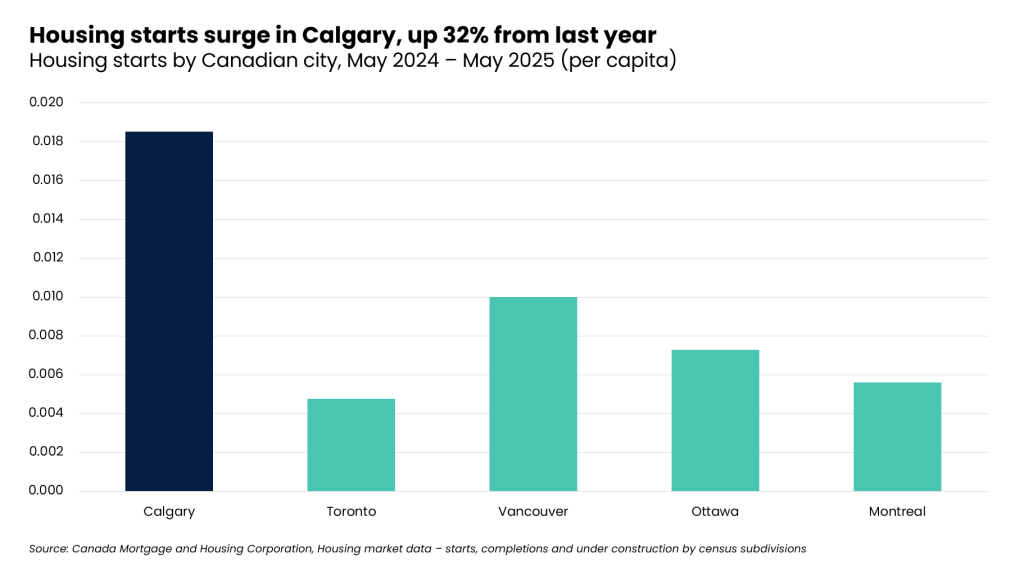In June 2024, we released Home Economics: Unlocking Growth Through Housing Solutions. One year later, the housing landscape has shifted — presenting new challenges and opportunities. Supply chains remain strained by global trade tensions and persistent labour disruptions. Skilled labour shortages continue to limit construction capacity while rising input costs are squeezing businesses already operating in a tough economic climate.
At the same time, political momentum to address housing affordability is stronger than it’s been in a generation. Governments at all levels are pursuing innovative solutions — including modular and prefabricated homes, mass timber and using new technologies — with investments underway nationwide.
- The City of Calgary committed $60 million through its Housing Capital Initiative to build new non-market housing.
- The Government of Alberta pledged $1.2 billion over three years to add 6,300 new affordable units.
- The Government of Canada has committed to launch Build Canada Homes, a new federal agency tasked with increasing housing starts to a rate of 500,000 per year over the next decade.
With bold commitments and progress being made to ensure housing starts keep pace with population growth, we must maintain our momentum. Alberta recently surpassed five million residents, and Calgary alone grew by nearly 220,000 people between 2020 and 2024. Immigration is driving economic growth and reflects Alberta’s relative affordable cost of living. To maintain this advantage, governments must take a long-term approach to housing and infrastructure development.
Alberta is expected to be home to 7.1 million people by 2051
Current Housing Trends
Alberta’s housing starts are up significantly:
- The seasonally adjusted annual rate (roughly May 2024 to May 2025) is 68,494 – 79 per cent higher than the five-year average.
- Year-to-date starts are 28 per cent higher than the same period in 2024.
- In Calgary alone, with support from the federal Housing Accelerator Fund, the City has incentivized the production of 44,726 units in the last 20 months.

By contrast, national housing starts are down one per cent — and if Alberta is excluded, year-to-date starts are down eight per cent. Political and media focus on housing is growing — and that momentum is beginning to improve access across the country. Governments must continue to prioritize housing affordability to ensure that businesses can grow and scale with the labour they need.
Why Housing Matters to Business
Housing affordability is essential to economic growth. Businesses rely on workers — and workers need access to appropriate, affordable housing. Without it, labour shortages will intensify, and wage pressures will increase. As cities grow, we need comprehensive plans that not only increase housing supply but also expand infrastructure: roads, public transit, utilities, waste collection and emergency services. Communities must be connected by efficient, affordable transportation and supported by core services.
Municipal
Investments made in housing are showing results – especially in Calgary’s rental and condo markets:
- From February 2024 to 2025 rental rates in Calgary declined six per cent.
- From June 2024 to 2025 the average condo sale price decreased by 1.6 per cent to $352,000.
That said, the City of Calgary has multiple levers it can use to build on the progress being made. The City can lower direct and indirect costs through varying application fees and decreasing timelines for approval. The City of Calgary’s housing strategy, Home is Here, must be fully implemented. Prioritizing increased density along key transportation corridors, developing a simple and business-friendly zoning bylaw and supporting innovative modular housing projects will be key to improving access to appropriate and affordable housing for all Calgarians.
In July 2024, the City of Calgary announced a $60 million investment made through their Housing Capital Initiative to support non-market housing. This is critical, as developing an increased supply of affordable housing reduces costs pressures on other segments of the housing market by allowing people who would be eligible but are currently occupying the lower end of the rental market to take advantage of non-market housing, easing demand in the rental housing market.
Continue to prioritize
- Technology: Leverage innovative technological solutions such as drones and AI to increase the efficiency of teams delivering inspection services, decreasing wait times for decisions on applications and improving productivity.
- Direct & indirect cost reductions: Decreasing government charges on new developments and reducing timelines for approvals as appropriate will improve the economics of housing development projects.
- Predictable regulation: Provide efficient and predictable timelines for development applications. Providing regulatory certainty allows businesses to plan appropriately, saving money and improving productivity. Implementing a strict six-week timeline for decisions on development and building permits would have a significant positive impact for home builders. In the interim, applications should be given clear and accurate timelines for approvals.
- Non-market housing: Continue investing in non-market housing, as increasing the stock of non-market housing takes pressure off the rest of the housing spectrum and improves economic outcomes for those who need access to affordable housing.
Provincial
Alberta’s housing market is showing signs of stabilization after the massive population increases experienced across the province over the last five years:
- From April 2024 to 2025 average rental rates in Alberta are down 0.4 per cent.
- From June 2024 to 2025 the average selling price for a detached home in Alberta increased 1.7 per cent to $607,000.
The provincial government will play a key role in supporting access to housing now and in the future. The province must work expeditiously to address gaps and accelerate training opportunities, as construction businesses are already facing skilled labour shortages. Alberta’s post-secondary institutions can help meet the demand for skilled labour but require support to do so.
Building codes must be harmonized across jurisdictions to ensure home builders can operate as efficiently as possible. Alberta’s construction industry would benefit from improved labour mobility, as governments across the country work to bring down internal trade barriers. Alberta’s construction sector currently has a 5.6 per cent job vacancy rate (sector average is 2.9 per cent), while Calgary’s job vacancy rate is 22 per cent. While the total volume of job vacancies has come down, the elevated rate in specific segments indicates that the labour market for construction remains constrained. The success of interprovincial migration hinges on efficient building code and labour standards harmonization.
Additionally, the province has a significant role to play in supporting non-market or social housing, through direct funding and partnership with municipalities and civic partners. In 2024, Alberta funded 798 new affordable (non-market) housing units through a combination of new-builds and rent subsidies, well below the stated goal by the Ministry of Seniors, Community and Social Services of 1,500 units. Recent funding announcements, including the provincial-federal agreement to allocate $203 million towards non-market housing will support the Government of Alberta in delivering on its commitment for affordable housing units available across the province. Increasing the supply of non-market affordable housing will reduce pressure on the lower end of the housing market (especially in the rental market) while decreasing cost pressures across the housing spectrum.
Continue to prioritize
- Labour & training: Increasing the number of seats in key programs such as schools of construction in post-secondary institutions, especially for high-demand programs that train skilled labour for the construction industry.
- Building codes: In partnership with federal, provincial and municipal governments and the business community, harmonize building codes and standards to reduce the regulatory burden on new builds.
- Non-market housing: Increasing the stock of non-market housing takes pressure off the rest of the housing spectrum and improves economic outcomes for those who need access to affordable housing.
Federal
Across the country, housing markets are cooling off from the surges experienced after the COVID-19 pandemic:
- From January 2024 to 2025 the advertised rental rates across Canada declined 2.7 per cent.
- From June 2024 to 2025 the average price of a condo decreased 5.2 per cent to $494,000.
- From June 2024 to 2025 the average price of a detached home decreased 3.4% to $776,000.
- In Q4 2024 Canada’s construction labour market faced a 2.9% job vacancy rate, down from a peak of 7.1 per cent in Q2 2022.
Programs like the Housing Accelerator Fund and the recently announced Build Canada Homes have the potential to support some of the significantly expanded growth in housing starts that will be needed in the coming years. Developing a stable suite of federal tools that financially support housing projects across the country will be essential to grow the rate of housing starts across the country. Furthermore, federal housing programs should provide funding for critical and enabling infrastructure — such as transit, connectivity and utilities — near future housing developments to help lower costs for developers and municipalities
To increase the speed and efficiency at which we produce housing, we need governments to support innovative construction methodologies and materials such as modular construction and mass timber.
To support our workforce now and in the future, the federal government should accept foreign credentials where appropriate, to ensure that construction businesses are supported with labour and talent they need to build homes across the country.
Supply chain disruptions have significantly impacted the Canadian housing market: since 2020, the price of home-building inputs has increased on average 58 per cent. Supply chain disruptions and labour shortages are also contributing to delays in home construction across the country, driving up both costs and project timelines.
Continue to prioritize
- Funding Programs: Prioritize the expansion of housing starts across the country through direct funding programs, such as the Housing Accelerator Fund. Target municipalities with high housing need and incentivize builders to produce higher density projects. Also, fund enabling infrastructure — such as transit, utilities and connectivity — near future housing sites to ease cost pressures on developers and municipalities.
- Innovative Construction: Encourage the development and adoption of innovation in the construction industry through new building techniques and technologies that will increase productivity and efficiency in housing construction.
- Credentialing: Support interprovincial and international credentialing to increase the available talent and skilled labour pool.
- Supply chain infrastructure: Invest in improved supply chain and trade enabling infrastructure to ensure builders can access materials efficiently, helping lower input costs and avoid delays.
Appendix – 2024 Recommendations
Muncipal
- Lowering Costs & Bureaucratic Burden: Lower the direct and indirect cost of building new housing by decreasing government charges on new developments where appropriate. Accelerate and standardize approval timelines for new developments, ensuring developers waiting for approval can pursue and complete projects in a timely manner. Implement efficient and innovative technologies for inspections to cut down on timelines, such as virtual inspections, which were used effectively during the COVID-19 pandemic.
- Zoning: To attract and retain talented workers in our cities, we must support the construction of appropriately dense and vibrant communities. The City of Calgary’s Residential Grade-Oriented Infill zoning policy supports the need for greater density, but ensuring transportation and infrastructure are appropriately supported will be key in the success of increasingly dense neighbourhoods and business communities.
- Social Housing: Provide ongoing financial support for non-market housing providers to alleviate pressures on market housing and accelerate the approval of development permits for buildings that include affordable housing. The City of Calgary’s property tax exemption for nonprofit organizations, such as those providing affordable housing, is critical to ensuring affordability of nonmarket housing. Further, deploy funding to maintain and refurbish social housing units where necessary, to avoid higher costs long term and ensure dignity for current residents. We also recommend working with private capital providers to accelerate these developments.
- Building Conversions: Expand our current housing stock by converting underutilized non-residential buildings to residential and incentivizing the construction of secondary suites. Include greater incentives such as a fast-track program for conversions that include affordable housing.
Provincial
- Red Tape Reduction: The provincial government must reduce red tape and bureaucratic burdens for entities looking to access key federal funding programs, such as the Housing Accelerator Fund to reduce the investments required by municipal and provincial governments. Creating barriers may lead to municipal entities in Alberta missing out on the federal financial supports needed to accelerate housing starts.
- Training: Increasing the number of seats in key programs such as schools of construction in postsecondary institutions, knowing demand for trades programs significantly exceeds capacity, with some programs reaching capacity hours after they open. To urgently address gaps and accelerate training opportunities, look at increasing the number of apprentices that can be trained by a journeyperson to exceed 2:1 where feasible. Alberta’s world-class post-secondary institutions can help meet the demand for skilled labour; however, they require strong provincial support to do so. Further, support international and interprovincial migrants with expertise in construction to transfer their credentials. We strongly suggest further expanding the dual credit program in high schools across the province, beyond the additional funding that was announced in April.
- Immigration: Create a dedicated immigration stream for credentialed tradespeople. Similar to the dedicated immigration stream for Tourism and Hospitality, the Government of Alberta should create a stream to support construction businesses. Further, to ensure adaptability and future flexibility in the immigration system, sector-specific nominee programs should sunset or be reviewed after five years.
- Zoning: Support municipalities in their efforts to ease zoning restrictions in key areas. Increasing density in cities, particularly near transit, and diversifying the types of housing being built will make more productive use of limited undeveloped land in cities. Recognizing the value of increased density where appropriate, while simultaneously increasing investment in key infrastructure such as schools, roads and green spaces, will be key to increasing available housing. Further, densification can support local businesses, as businesses thrive in more populated areas.
- Building Codes: In partnership with federal, provincial and municipal governments, and the business community, harmonize building codes and reduce the regulatory burden on new builds. Prioritize efficient projects with fast turnaround times to develop more housing stock faster, especially in areas that may be underdeveloped.
- Social Housing: In partnership with federal, provincial and municipal governments and non-profit housing providers, expand non-market social housing stock to support vulnerable people and alleviate pressure on the housing market. Exempting property tax for non-profit housing is an important step forward in improving the affordability of these homes. Further, invest in current social housing units to avoid long-term higher maintenance and repair costs, and ensure dignity for current residents.
Federal
- Funding Programs: Prioritize the expansion of housing starts across the country through direct funding programs, such as the Housing Accelerator Fund. Target municipalities with high housing need and incentivize builders to produce higher density projects. We also encourage the federal government to reduce red tape and avoid creating narrow constraints or conditions, ensuring funding moves quickly to provide certainty for project proponents. Provide additional funding support for critical and enabling infrastructure such as transit, connectivity and utilities, near future housing developments to reduce the cost burden on developers and municipalities.
- Innovative Construction: Encourage the development and adoption of innovation in the construction industry through new building techniques and technologies that will increase productivity and efficiency in housing construction. Supporting business that deploy prefabricated, modular or manufactured housing and make use of innovative materials such as mass timber can drive productivity in our construction sector. Provide direct support through grants, tax incentives or other programs, for innovative home builders and materials developers to decrease the cost of construction.
- Supply Chains: Bolster supply chains to ensure that across the country, builders have timely access to the materials needed to accelerate production. Given the industry relies on work occurring in a specific order, seemingly minor supply chain challenges can hold up projects for extended periods of time. Investments in ports, rail terminals and aviation hubs, and working collaboratively – or even proactively – to minimize labour disruptions, will help boost the resilience of our supply chains.
- Social Housing: Provide direct financial support for non-market housing, striving to double current supply. In 2023, Scotiabank showed Canada must double our current stock of social housing. By investing in increased non-market housing units, and developing public-private partnerships where feasible, pressure can be alleviated across the housing spectrum.
- Credentialling: Support interprovincial and international credentialing to increase the available talent and skilled labour pool. By increasing the number of credentialed workers, input costs will decrease and the number of homes that can be developed will increase due to greater capacity.







